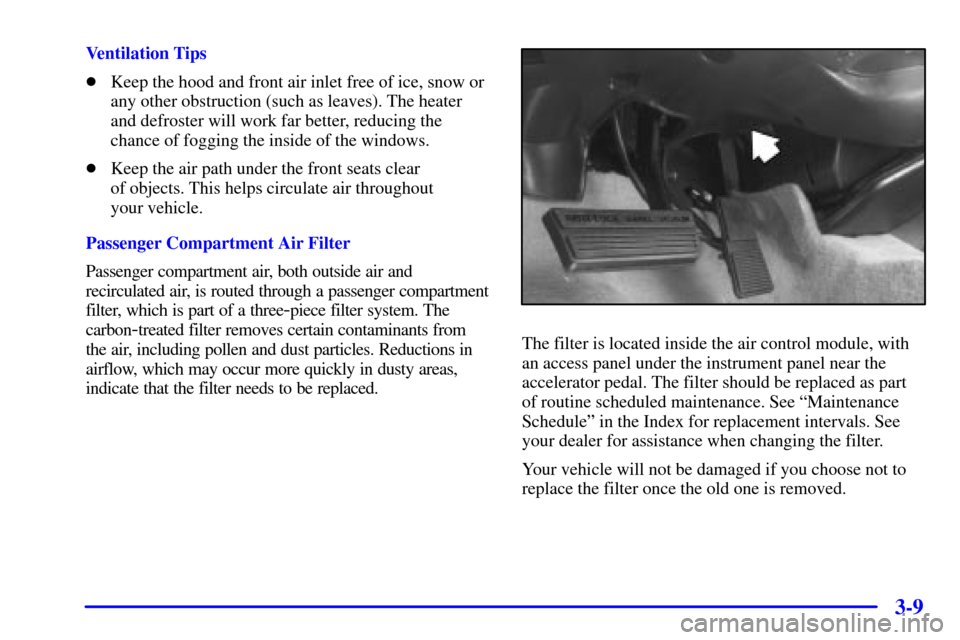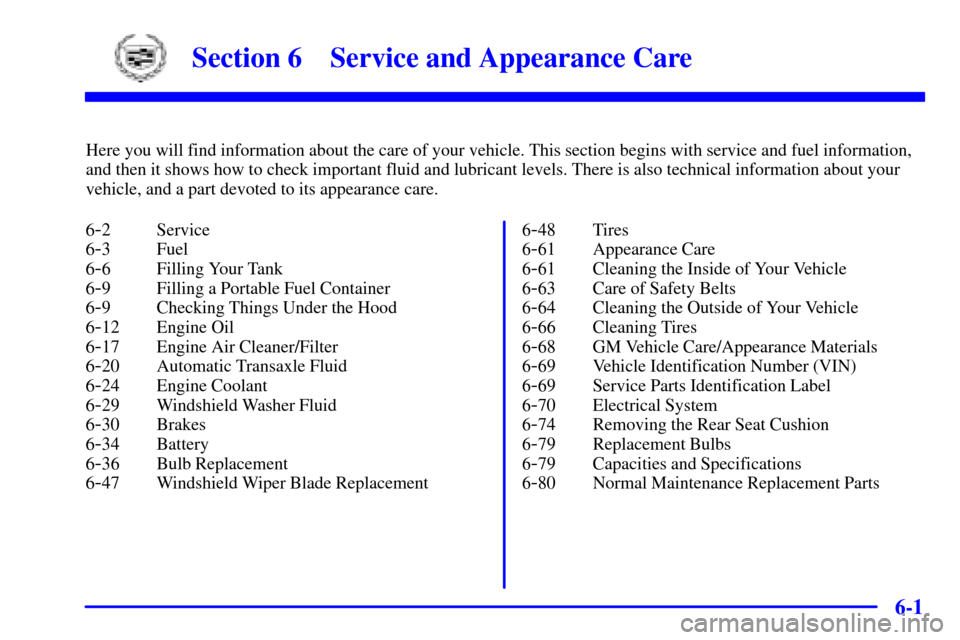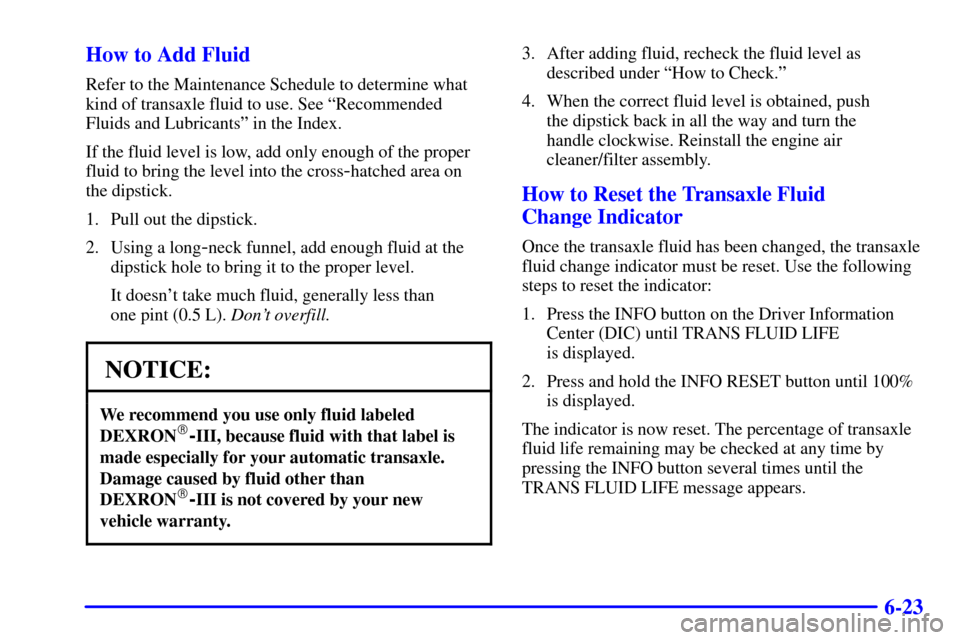Page 181 of 399

3-9
Ventilation Tips
�Keep the hood and front air inlet free of ice, snow or
any other obstruction (such as leaves). The heater
and defroster will work far better, reducing the
chance of fogging the inside of the windows.
�Keep the air path under the front seats clear
of objects. This helps circulate air throughout
your vehicle.
Passenger Compartment Air Filter
Passenger compartment air, both outside air and
recirculated air, is routed through a passenger compartment
filter, which is part of a three
-piece filter system. The
carbon
-treated filter removes certain contaminants from
the air, including pollen and dust particles. Reductions in
airflow, which may occur more quickly in dusty areas,
indicate that the filter needs to be replaced.The filter is located inside the air control module, with
an access panel under the instrument panel near the
accelerator pedal. The filter should be replaced as part
of routine scheduled maintenance. See ªMaintenance
Scheduleº in the Index for replacement intervals. See
your dealer for assistance when changing the filter.
Your vehicle will not be damaged if you choose not to
replace the filter once the old one is removed.
Page 282 of 399

6-
6-1
Section 6 Service and Appearance Care
Here you will find information about the care of your vehicle. This section begins with service and fuel information,
and then it shows how to check important fluid and lubricant levels. There is also technical information about your
vehicle, and a part devoted to its appearance care.
6
-2 Service
6
-3 Fuel
6
-6 Filling Your Tank
6
-9 Filling a Portable Fuel Container
6
-9 Checking Things Under the Hood
6
-12 Engine Oil
6
-17 Engine Air Cleaner/Filter
6
-20 Automatic Transaxle Fluid
6
-24 Engine Coolant
6
-29 Windshield Washer Fluid
6
-30 Brakes
6
-34 Battery
6
-36 Bulb Replacement
6
-47 Windshield Wiper Blade Replacement6
-48 Tires
6
-61 Appearance Care
6
-61 Cleaning the Inside of Your Vehicle
6
-63 Care of Safety Belts
6
-64 Cleaning the Outside of Your Vehicle
6
-66 Cleaning Tires
6
-68 GM Vehicle Care/Appearance Materials
6
-69 Vehicle Identification Number (VIN)
6
-69 Service Parts Identification Label
6
-70 Electrical System
6
-74 Removing the Rear Seat Cushion
6
-79 Replacement Bulbs
6
-79 Capacities and Specifications
6
-80 Normal Maintenance Replacement Parts
Page 292 of 399
6-11 Engine Compartment Overview
When you open the hood, you'll see:
A. Windshield Washer Fluid Reservoir
B. Underhood Fuse Block
C. Power Steering Fluid Reservoir
D. Engine Oil Fill LocationE. Engine Oil Dipstick
F. Brake Master Cylinder Reservoir
G. Transaxle Fluid Cap and DipstickH. Engine Air Cleaner/Filter
I. Engine Coolant Surge Tank and
Pressure Cap
Page 298 of 399
6-17
Engine Air Cleaner/Filter
The engine air cleaner/filter is located next to the
coolant surge tank on the driver's side of the vehicle.
See ªEngine Compartment Overviewº in the Index for
more information on location. Be sure the engine has
cooled before following these steps to replace the engine
air cleaner/filter:
1. Loosen the air duct
clamp, which is located
at the mass airflow
sensor end of the
air duct.
2. Disconnect the air duct from the mass airflow sensor.
Page 299 of 399
6-18
3. Unhook both of the engine air cleaner/filter
cover latches.
4. Move the cover out of the way.5. Take out the engine air cleaner/filter and remove any
loose debris that may be found lying in the base.
6. Install a new air filter element. See ªNormal
Maintenance Replacement Partsº in the Index for the
proper type.
Page 300 of 399

6-19
Follow these steps to reinstall the engine air
cleaner/filter assembly:
1. Slide the cover into the slots in the bottom of
the base.
2. Close the cover and make sure that both latches are
secure and fully engaged.
3. Reinstall the clean air duct over the mass airflow
sensor. Make sure that the duct is secure around the
entire outer edge of the sensor.
4. Tighten the air duct clamp.
Refer to the Maintenance Schedule to determine when to
replace the air filter.
See ªScheduled Maintenance Servicesº in the Index.
CAUTION:
Operating the engine with the air cleaner/filter
off can cause you or others to be burned. The air
cleaner not only cleans the air, it stops flame if
the engine backfires. If it isn't there, and the
engine backfires, you could be burned. Don't
drive with it off, and be careful working on the
engine with the air cleaner/filter off.
NOTICE:
If the air cleaner/filter is off, a backfire can
cause a damaging engine fire. And, dirt can easily
get into your engine, which will damage it.
Always have the air cleaner/filter in place when
you're driving.
Page 303 of 399
6-22
Then, without shutting off the engine, follow
these steps:
The transaxle fluid cap is
located next to the radiator
hose and below the engine
air cleaner/filter assembly in
the engine compartment on
the driver's side of the
vehicle. See ªEngine
Compartment Overviewº in
the Index for more
information on location.
1. After removing the engine air cleaner/filter assembly
to reach the transaxle fluid cap, turn the cap
counterclockwise to remove. Pull out the dipstick
and wipe it with a clean rag or paper towel.
2. Push it back in all the way, wait three seconds and
then pull it back out again.
3. Check both sides of the dipstick, and read the
lower level. The fluid level must be in the
cross
-hatched area.
4. If the fluid level is in the acceptable range, push
the dipstick back in all the way and turn the
handle clockwise. Reinstall the engine air
cleaner/filter assembly.
Page 304 of 399

6-23 How to Add Fluid
Refer to the Maintenance Schedule to determine what
kind of transaxle fluid to use. See ªRecommended
Fluids and Lubricantsº in the Index.
If the fluid level is low, add only enough of the proper
fluid to bring the level into the cross
-hatched area on
the dipstick.
1. Pull out the dipstick.
2. Using a long
-neck funnel, add enough fluid at the
dipstick hole to bring it to the proper level.
It doesn't take much fluid, generally less than
one pint (0.5 L). Don't overfill.
NOTICE:
We recommend you use only fluid labeled
DEXRON�-III, because fluid with that label is
made especially for your automatic transaxle.
Damage caused by fluid other than
DEXRON
�-III is not covered by your new
vehicle warranty.
3. After adding fluid, recheck the fluid level as
described under ªHow to Check.º
4. When the correct fluid level is obtained, push
the dipstick back in all the way and turn the
handle clockwise. Reinstall the engine air
cleaner/filter assembly.
How to Reset the Transaxle Fluid
Change Indicator
Once the transaxle fluid has been changed, the transaxle
fluid change indicator must be reset. Use the following
steps to reset the indicator:
1. Press the INFO button on the Driver Information
Center (DIC) until TRANS FLUID LIFE
is displayed.
2. Press and hold the INFO RESET button until 100%
is displayed.
The indicator is now reset. The percentage of transaxle
fluid life remaining may be checked at any time by
pressing the INFO button several times until the
TRANS FLUID LIFE message appears.